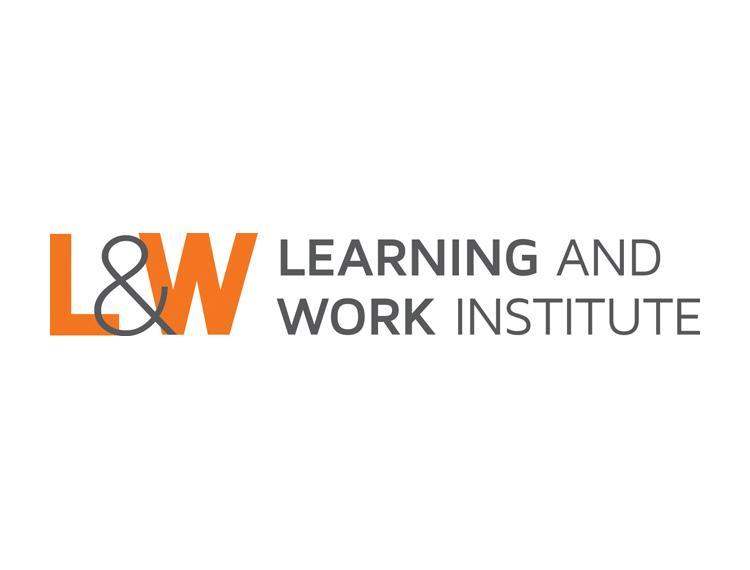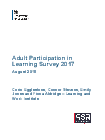Learning is Crucial to Future Prosperity, Fairness and Social Inclusion in the UK

Adult Participation in Learning Survey 2017
Results of a survey into adult learning – participation, motivation, barriers to learning and benefits experienced.
Learning has positive benefits for individuals, communities and the wider economy. Increasing and widening access to learning is crucial to future prosperity, fairness and social inclusion in the UK.
Despite the strength of this evidence, the UK has seen a recent decline in the number of adults participating in learning and training. If we are to engage more adults in learning, it is vital that we understand patterns of behaviour, and adults’ motivations and their barriers to their engagement.
For over 20 years, Learning and Work Institute (L&W) has undertaken an annual survey of adult participation in learning. The survey, which draws on data from a national representative survey of 5,000 adults across the UK (or Great Britain in 2017), provides a rich evidence base on who participates in learning, their motivations, barriers, and benefits experienced.
This report presents the findings from the 2017 survey, which was funded by the Department for Education (DfE). This report also provides, for the first time, segmented statistical analysis using disadvantage indicators to explore what the policy levers might be to engaging adults who are historically least likely to learn.
Methods
The 2017 Adult Participation in Learning Survey included 5,169 adults aged 17 and over across Great Britain, with fieldwork conducted in September and October 2017.
This sample has been weighted (generating an effective sample of 5,039) to provide a nationally representative dataset. The survey deliberately adopted a broad definition of learning, including a wide range of formal, non-formal and informal learning, far beyond the limits of publicly offered educational opportunities for adults.
Analysis of the survey results predominately involved a mixture of descriptive statistics and the significance testing of demographic and key variable breakdowns.
A segmented approach was used to analyse a number of questions to compare results between different defined groups of respondents. This included the following analyses: by main reason for learning, by likelihood of future learning, by index of multiple deprivation, by index of multiple disadvantage in employment and regression analysis.
Key findings
Who participates in learning?
Analysis of participation by different demographic characteristics indicates that:
- Women have a significantly higher participation rate than men.
- Individuals from higher social grades are more likely to be participating in learning than those from lower social grades.
- Working status is a key predictor of participation; closer proximity to the labour market is associated with higher participation rates. Full and part-time workers are equally likely to be participating in learning.
- There is a strong effect of age on participation rate. Each age group has a significantly higher participation rate than the next oldest group, with one exception: the 25 to 34 group have slightly lower rates than the 35 to 44 group.
- Respondents from BAME backgrounds are significantly and substantially more likely to be participating in learning than respondents from White backgrounds.
- The age at which respondents completed full-time education is strongly associated with participation in learning, with those who left full-time education at 16 or under being the least likely to have current or recent experience of learning. Remaining in education until at least the age of 21 is associated with the highest participation rate.
- Participation in learning is lower among adults who have higher levels of disadvantage in employment and those who live in areas that have the highest levels of multiple deprivation.
Two-fifths (40%) of survey respondents stated an intention to learn in the next three years, which is similar to the current participation rate. A slightly higher proportion of 43 per cent said that they are very unlikely to take part in learning and a further 15 per cent considered themselves fairly unlikely to do so.
What motivates adults to learn?
The survey shows that three-quarters (75%) of learners took up their main learning for work or career related reasons, and just under a quarter (24%) for leisure or personal interest.
Some groups of adults were more likely to learn for work or career related reasons than others, including: younger respondents below the age of 35; adults in C1 and C2 social grades; and employed adults, particularly those in full-time work.
In contrast, adults who are more likely to be motivated to learn for leisure or personal interest are more likely to be: older respondents aged 65 and over; and retired adults. Adults are motivated to take up learning for a range of reasons.
Around a quarter of respondents said they started learning to develop themselves as a person (27%); to help improve in their job (27%); due to an interest in the subject (26%); or to get a recognised qualification (24%). A further fifth of learners (22%) are learning because they enjoy it.
Where do adults learn?
The survey results show that adults learn in a range of different locations. Over half (55%) of learners participated in work-related learning and a further 41 per cent learnt independently. Just over a third (34%) of respondents learnt in a formal educational establishment and six per cent in a community or voluntary organisation.
This indicates that provision should be flexible to adults’ lives and be offered in the workplace and remotely (for example through online learning), as well as through formal education institutions.
What do adults learn?
Adults are learning a range of subjects, including health and science; digital, computer skills and IT; business and administrative; creative and design; and childcare and education.
Around two-thirds (67%) of people’s main learning leads to a qualification. Age is a strong predictor of learning for a qualification, with more than nine out of 10 learners aged 17-24 saying their learning will result in a qualification.
What do adults invest in learning?
The survey results indicate that adults’ learning is paid for in a range of ways. Most commonly, individuals’ employers paid for their learning (29%), adults paid the fee directly (22%), no fee was attached to the learning (22%), or learners took out a formal learning loan (such as a Student Loan, Advanced Learner Loan or Career Development Loan) to pay for their learning (8%).
Adult learners also invest time in learning, which often competes with other priorities, such as work and caring responsibilities. Most commonly survey respondents reported spending three to four hours on learning per week. The mean number of hours spent learning a week is 15.1 hours.
What are adults’ barriers to learning?
Overall, the barrier to learning most frequently identified by survey respondents, regardless of their learning status, was work or other time pressures. While current/recent learners cite other situational barriers, such as cost and childcare or caring responsibilities, adults who have not been learning for at least three years were more likely to cite dispositional barriers, such as feeling too old and a lack of interest.
Nearly two out of five (38%) non-learners say that nothing is preventing them from doing so, which potentially indicates that learning is not something they have considered or that they feel would be of value for them.
What might encourage adults to learn in the future?
The survey results highlight a range of factors that could make learning more attractive to them in the future. The most common responses were: if it was cheaper or the fees were lower; if it was related to something that they were interested in; if they could learn from home. Almost two-fifths (38%) of adults, however, said that nothing would make them more likely to take up learning.
Adults with higher level qualifications and those in higher social grades are most likely to identify factors that would address situational barriers, such as finance and practical support. They are also more likely to be able to identify the factors that would enable them to participate.
What are the benefits of adult learning?
Learning as an adult can have significant benefits for individuals, including those related to health, employment, and social life and community. The most common benefits cited by learners were improvement in knowledge of the subject; improved skills related to their job; self-confidence; increased confidence at work; and enjoying learning more.
Where do adults find out about learning?
When asked to choose what their first step would be if they were to take part in future learning, almost one in five adults (17%) selected a general internet search for courses of interest. Over one in ten stated that they would contact their local college, university or learning centre (14%) or that they would talk to their employer (11%). However, over a quarter of adults (26%) did not choose any of the options given.
What are adults’ attitudes towards post-16 provision?
All respondents were asked to indicate how likely they would be to: do an apprenticeship or higher apprenticeship; go to college to do a vocational qualification; and/or go to university to do a degree. The results indicate that adults would be most likely to go to college to do a vocational qualification, followed by university and then do an apprenticeship or higher apprenticeship.
All respondents were also asked to state how likely they would be to recommend each of the post-16 education options to a family member or friend. The results show at least three-quarters of respondents would be likely to recommend each option. This suggests that participation in any of these types of provision may not necessarily reflect their perceived value, with a substantially greater proportion of respondents saying they would recommend each type of provision even if they are unlikely to take up these opportunities themselves.
Considerations for policy and practice
The evidence from this study highlights the following considerations for policy and practice, aimed at engaging more and different adults in learning:
- The survey consistently shows inequalities in participation in learning. To engage more and different adults in learning, outreach and interventions should seek to target adults in lower social grades, adults who are furthest from the labour market, older adults, and those who left full-time education at their earliest opportunity.
- Around three-fifths (58%) of survey respondents stated they are unlikely to take part in learning in the next three years. Current/recent learners are more likely to intend to carry on, suggesting that encouraging adults to try out learning, and providing support for them to continue to do so, are important to increasing participation overall.
- The survey results demonstrate the wide variety of motivations to learn. As such, ensuring a breadth of opportunities – including those directly related to the workplace – is important to successfully engage more adults in learning. Unemployed adults and individuals experiencing higher levels of disadvantage, are more likely to be motivated by benefits relating to learning and knowledge, social and community, or health and wellbeing. To engage disadvantaged groups in learning, the learning offer may be more attractive if it relates to these motivations.
- Adults learn in a range of different locations and engage with different types of provision. A broad learning offer therefore needs to be available to adults and should be delivered flexibly, including in the workplace and remotely (for example through online learning), as well as through formal education institutions.
- Current/recent learners cite situational barriers, such as cost and childcare or caring responsibilities. Adults who have not been learning for at least three years were more likely to cite dispositional barriers, such as feeling too old and a lack of interest. In addition to removing practical barriers to learning, it is therefore important to engage adults by making the case of the value and relevance of learning to them.
- Although cost is a barrier to many adults, the survey demonstrates that some adults are willing to invest in their learning. The government and providers should therefore ensure that the value of this investment is visible to potential learners and employers. The government should also consider measures that encourage greater levels of co-investment in learning
- Adults look for information about learning from a wide range of sources. In order to engage adults who are least likely to learn, relevant information should be made available in public places and through individuals and services that people come into contact with.
- A significantly higher proportion of respondents from BAME than White backgrounds say that they are likely to do an apprenticeship. The results suggest that the appetite for apprenticeships exists and therefore efforts should be focused on ensuring individuals are successful in accessing opportunities.
Documents

Adult participation in learning survey 2017
Ref: ISBN 978-1-78105-908-1, DFE-RR818PDF, 1.56MB, 92 pages
Details
This report presents detailed findings from a survey of over 5,000 adults who participate in learning. It explores:
- their motivations
- what and where they learn
- their investment in learning
- the benefits they experience
It also includes findings on barriers to learning faced by adult learners and non-learners, and factors that could encourage adults to take up learning.
Further research into the barriers to learning that affect disadvantaged adults has also been published.











Responses